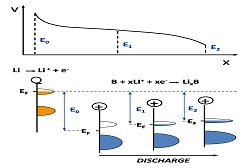Claude Delmas
University of Bordeaux, France
Title: Solid state electrochemistry: A tool for synthesis and characterization of solids
Biography
Biography: Claude Delmas
Abstract
Researches on battery materials has considerably increased during the last 30 years due to the huge development of lithium-ion batteries for portable devices and electric vehicles and more recently with the need to store energy in order to optimize its consumption. The chemical reactions occurring within the two electrodes are topochemical where the skeleton (2d or 3D) of the structure is preserved. The cell voltage is equal to the difference in fermi level between the two electrodes. If one electrode exhibits a constant voltage it can acts as reference and therefore, the cell voltage reflects all structure modifications which occurs on the material upon intercalation. The change is cell voltage depends on: The electronic band filling, the changes in the band structure due to change in composition, the modification of the Magdelung energy. In this schematic example, the monotonous decreases of the voltage during the intercalation reaction indicate that the reaction occurs through a monophasic domain. In numerous cases, the reaction mechanism is more complicated and involves biphasic domains and/or formation of materials with a specific composition. The voltage vs. composition curve is much more complicated and gives directly the phase diagram on the studied systems. For the solid state chemist the studies of the electrochemical reaction using a battery opens new possibility to determine phase diagram at RT, but also to synthesize new metastable phases from a precursor made by classical solid state chemistry. Exchange between alkali ions can be also considered in this frame. In this presentation, we report here about the NaxMO2 (M=3d elements) systems with a special focus on the phase diagram and the synthesis of new materials.

Recent Publications
- Tournadre F, Croguennec L, Saadoune I, Carlier D, Y. Shao-Horn, Willmann P, Delmas C. On the mechanism of the P2-Na0.70CoO2 ® O2-LiCoO2 exchange reaction. J. Solid State Chem. 177 (8), 2790(2004)..
- Berthelot R, Carlier D, Delmas C. Electrochemical investigation of the P2– NaxCoO2 phase diagram. Nature Materials, 10(1), 74 (2001).
- Guignard M, Didier C, Darriet J, Bordet P, Elkaïm E, Delmas C. Vanadium Clustering/Declustering in P2-Na1/2VO2 Layered Oxide. Nature Mat 12, 74 (2013).
- Guignard M, Carlier D, Didier C, Delmas C. On the mechanism of the P2- Na0.70CoO2 ® O2-LiCoO2 exchange reaction.Chem. Mat. 26(4) 1538 (2014).
- Delmas C. Operating through Oxygen. Nature Chem., 8, 641 (2016).

